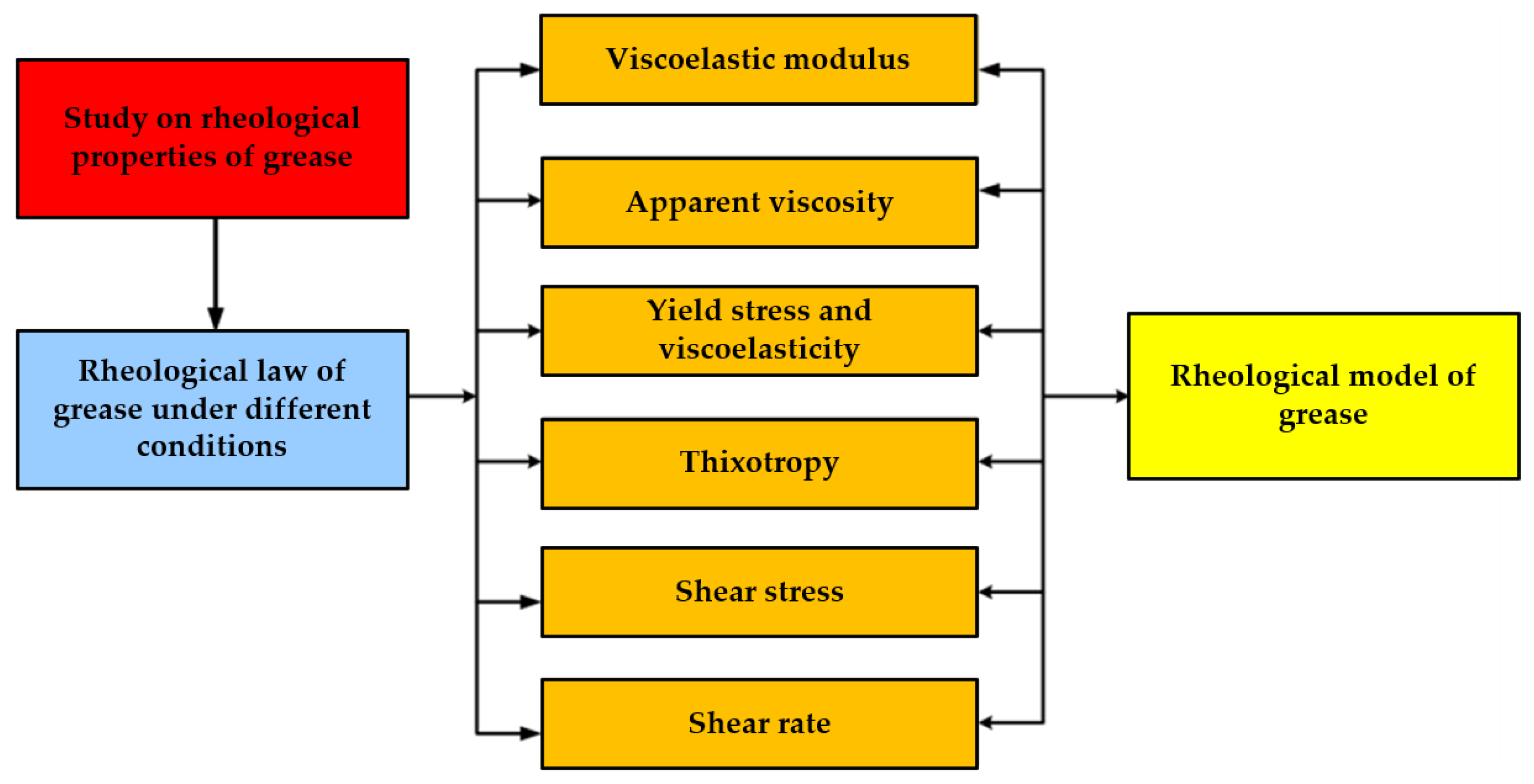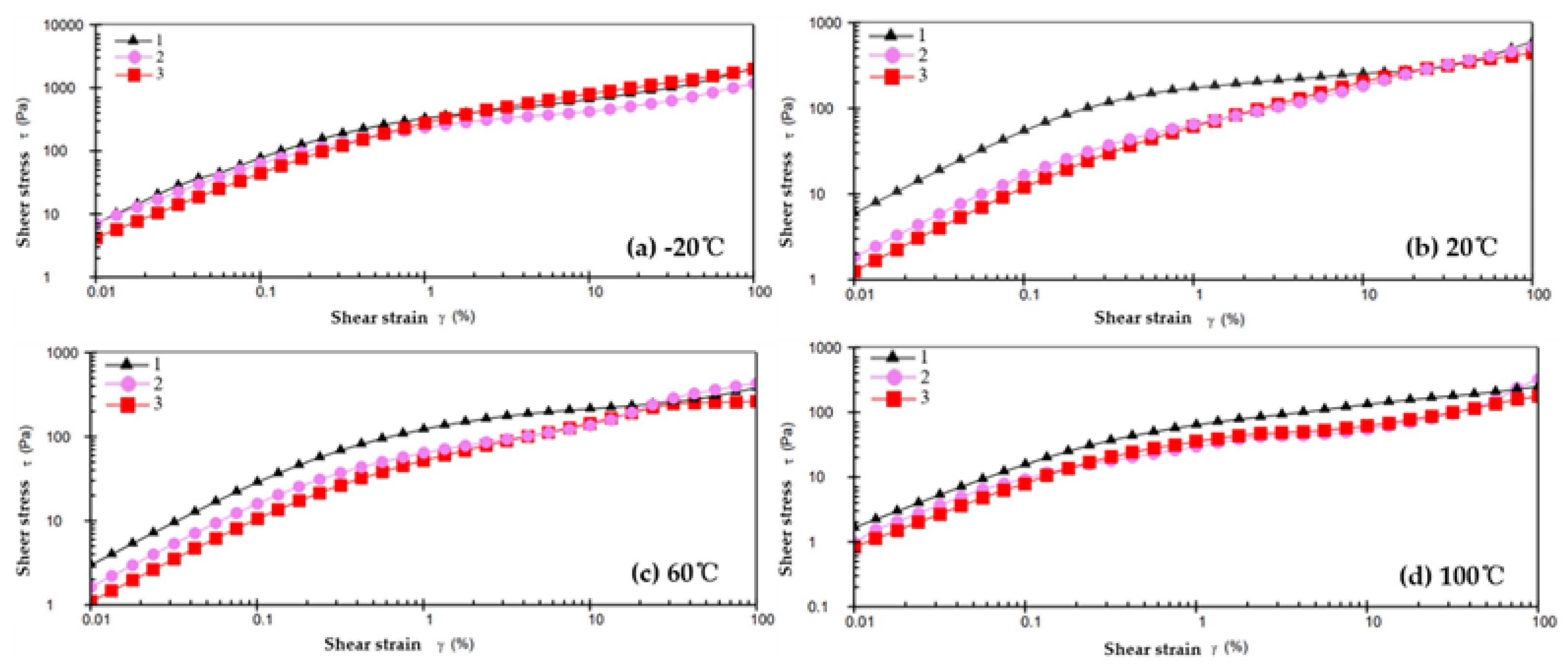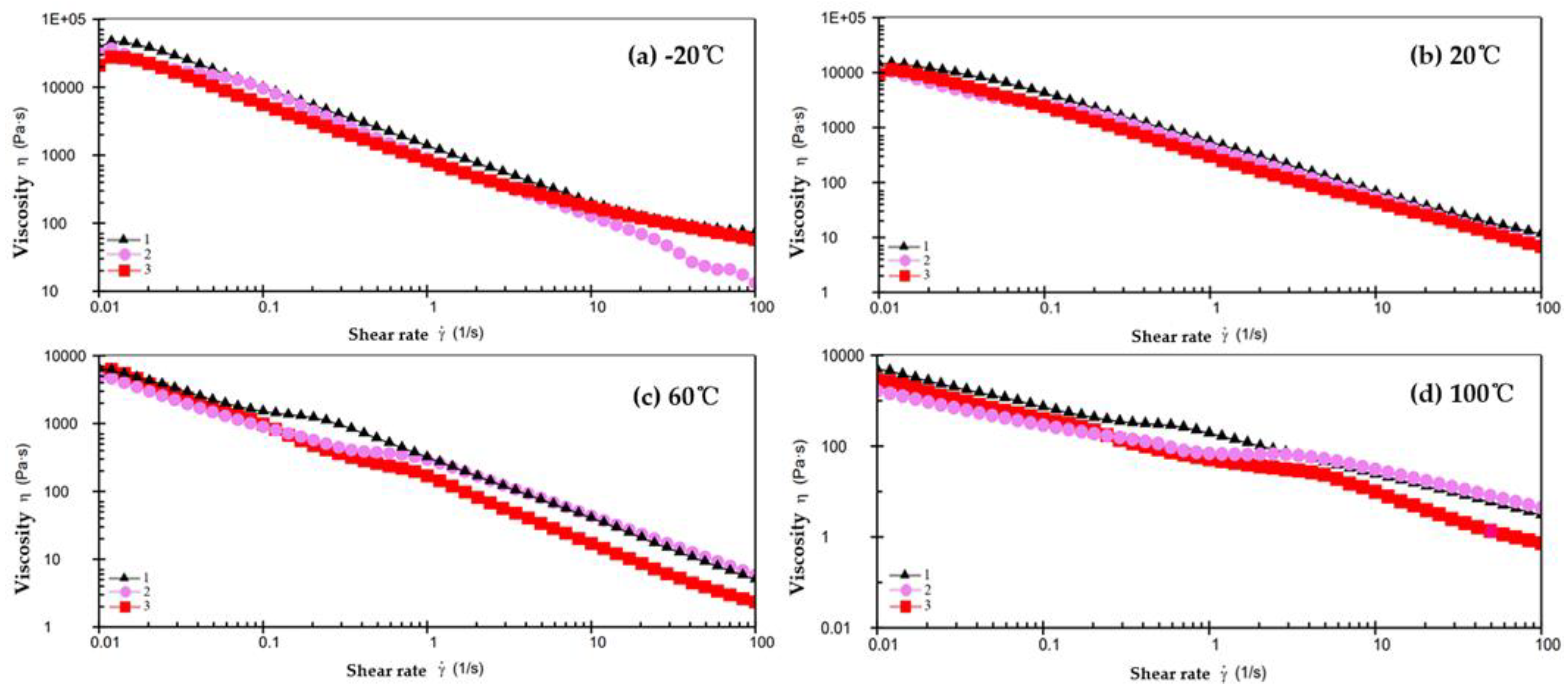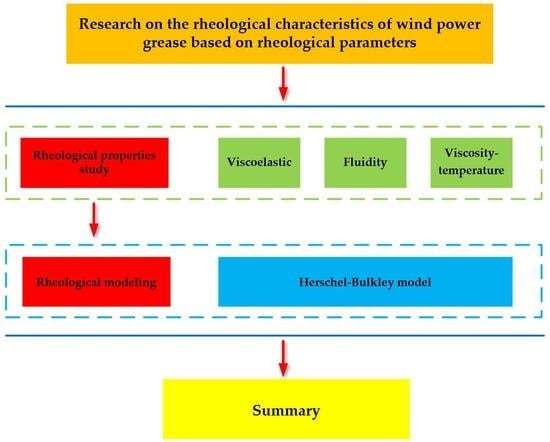Research on the Rheological Characteristics of Wind Power Grease Based on Rheological Parameters
Abstract
:1. Introduction
2. Experimental Section
2.1. Test Equipment
2.2. Test Scheme Design
- Dynamic rheological test
- 2.
- Steady-state rheological test
2.3. Grease Selection
3. Experimental Results and Discussion
3.1. Influence of Grease Viscoelastic Properties on Bearing Lubrication
3.2. Influence of Grease Fluidity on Bearing Lubrication
3.3. Influence of Grease Viscosity–Temperature Characteristics on Bearing Lubrication
3.4. Results and Discussion
- From the stress–strain curves of grease samples 1, 2, and 3 at different temperatures and the corresponding energy storage and loss modulus with strain, it can be seen that different greases have different viscoelastic properties at different temperatures. At a low temperature, the storage modulus and loss modulus of grease are higher, which means that the grease has better elasticity and viscoelasticity under these conditions and can better perform in terms of lubrication and buffering. Meanwhile, at a high temperature, the loss modulus of grease obviously increases, which indicates that the viscoelastic capacity decreases, and the viscosity of grease decreases, which reduces the lubricating effect.
- Under each temperature condition, the shear stress of the three greases increased with the increasing shear rate, while the viscosity decreased with the increasing shear rate, but the decreasing and increasing trends of the three samples were different. The grease flow curve also shows that temperature has an effect on its rheological properties. For wind turbine spindle bearings, it is important to focus on the grease’s viscosity change and shear resistance at high temperatures to ensure efficient bearing lubrication.
- Grease viscosity is closely related to temperature and has an essential effect on the lubrication performance of wind turbine bearings. If the viscosity of the grease drops too low, the lubricating film will be lost because the grease cannot maintain sufficient adhesion at high temperatures, resulting in overheating, wear, and corrosion of wind turbine bearings. Therefore, when selecting grease, if the application environment’s temperature is low, it is necessary to select grease with a higher viscosity to ensure the lubricating effect. In a high-temperature environment, it is necessary to select grease with a lower viscosity to avoid the effect of lubrication due to a high viscosity.
4. Rheological Modeling
5. Summary
- As the temperature increases, the slope of the stress–strain curve of the grease becomes smaller, indicating that the grease flows more easily under high-temperature conditions, while the increase in temperature also causes the storage modulus and loss modulus of the grease to decrease. At a low temperature, the viscoelastic modulus of grease is higher, and with increasing temperature, the viscoelastic modulus gradually decreases.
- The shear stress of the grease increases with increasing shear rates, which is in contrast to the decrease in viscosity with increasing shear rates. In addition, as the temperature increases, the thermal movement of the molecules in the grease increases, resulting in a decrease in the intermolecular interaction force and a looser arrangement, which reduces the viscosity of the grease and makes it easy to lose lubrication at high temperatures and shear rates. For operating wind turbine spindle bearings at high speeds, it is best to select a grease that can resist shear at high temperatures to ensure the good lubrication performance of the bearings.
- The viscosity of grease decreases as the temperature increases, primarily because the grease molecules flow more easily at high temperatures, resulting in a decrease in the grease viscosity. When selecting a grease, it is necessary to consider its viscosity and temperature characteristics. In high-temperature conditions, the use of lower-viscosity grease can ensure the lubrication performance of wind power spindle bearings; in contrast, in low-temperature conditions, the use of higher-viscosity grease can better maintain the fluidity of the grease.
- The H–B model can reflect the sensitivity of the grease viscosity–temperature behavior to temperature changes. The intrinsic equation of grease obtained by fitting the H–B model can effectively predict the rheological properties and viscosity–temperature behavior of grease at different temperatures, which provides a reference for predicting the performance of grease under different conditions.
Author Contributions
Funding
Institutional Review Board Statement
Data Availability Statement
Conflicts of Interest
References
- Yan, J.; Liu, Y.; Ren, X. An Early Fault Detection Method for Wind Turbine Main Bearings Based on Self-Attention GRU Network and Binary Segmentation Changepoint Detection Algorithm. Energies 2023, 16, 4123. [Google Scholar] [CrossRef]
- Available online: https://www.sohu.com/a/553148021_120097033 (accessed on 1 June 2022).
- Available online: https://www.163.com/dy/article/H4P0LA660514C30V.html (accessed on 12 April 2022).
- Afridi, Y.S.; Hasan, L.; Ullah, R.; Ahmad, Z.; Kim, J.-M. LSTM-Based Condition Monitoring and Fault Prognostics of Rolling Element Bearings Using Raw Vibrational Data. Machines 2023, 11, 531. [Google Scholar] [CrossRef]
- Bayer, G.; Bartschat, A.; Wandel, S.; Baust, S.; Poll, G. Experimental Investigations on Wear in Oscillating Grease-Lubricated Rolling Element Bearings of Different Size and Type. Lubricants 2023, 11, 120. [Google Scholar] [CrossRef]
- Wandel, S.; Bader, N.; Schwack, F.; Glodowski, J.; Lehnhardt, B.; Poll, G. Starvation and relubrication mechanisms in grease lubricated oscillating bearings. Tribol. Int. 2022, 165, 107276. [Google Scholar] [CrossRef]
- Frache, L.; Komba, E.H.; Philippon, D.; Galipaud, J.; De Barros, M.; Douillard, T.; Masenelli-Varlot, K.; Bouscharain, N.; Maheo, Y.; Sarlin, R.; et al. Observation of a modified superficial layer on heavily loaded contacts under grease lubrication. Tribol. Int. 2021, 158, 106921. [Google Scholar] [CrossRef]
- Bell, J.C. Lubrication of Rolling Surfaces by a Ree-Eyring Fluid. ASLE Trans. 1962, 5, 160–171. [Google Scholar] [CrossRef]
- Henryk, F.; Bogdan, W. Correction of the roller generators in spherical roller bearings. Wear 1996, 192, 29–39. [Google Scholar]
- Wang, Z.; Chang, J.; Cai, C. Tribological Performance of Phosphonium Ionic Liquids as Additives in Lithium Lubricating Grease. Lubricants 2018, 6, 23. [Google Scholar] [CrossRef] [Green Version]
- Mohamad, N.; Ubaidillah; Mazlan, S.A.; Choi, S.-b.; Abdul Aziz, S.A.; Sugimoto, M. The Effect of Particle Shapes on the Field-Dependent Rheological Properties of Magnetorheological Greases. Int. J. Mol. Sci. 2019, 20, 1525. [Google Scholar] [CrossRef] [Green Version]
- Wang, H.; Zhang, G.; Wang, J. Quasi-Static Rheological Properties of Lithium-Based Magnetorheological Grease under Large Deformation. Materials 2019, 12, 2431. [Google Scholar] [CrossRef] [Green Version]
- Mohd Nasir, N.A.; Nazmi, N.; Mohamad, N.; Ubaidillah, U.; Nordin, N.A.; Mazlan, S.A.; Abdul Aziz, S.A.; Shabdin, M.K.; Yunus, N.A. Rheological Performance of Magnetorheological Grease with Embedded Graphite Additives. Materials 2021, 14, 5091. [Google Scholar] [CrossRef] [PubMed]
- Yan, H.; Li, P.; Duan, C.; Dong, X. Studies with Rheological Behavior of Composite Lithium-Based Magnetorheological Grease. Metals 2021, 11, 1826. [Google Scholar] [CrossRef]
- Wang, Y.; Gao, X.; Lin, J.; Zhang, P. Rheological and Frictional Properties of Lithium Complex Grease with Graphene Additives. Lubricants 2022, 10, 57. [Google Scholar] [CrossRef]
- Svetlana, N.; Anastasiya, Y.; Sergey, O. Rheological and tribological properties of low-temperature greases based on cellulose acetate butyrate gel. Carbohydr. Polym. 2021, 272, 118509. [Google Scholar]
- Lugt, P.M.; van Zoelen, M.T.; Vieillard, C.; Berens, F.; Gruell, R.; Preisinger, G.; Meaney, P. Grease performance in ball and roller bearings for all-steel and hybrid bearings. Tribol. Trans. 2021, 65, 1–13. [Google Scholar] [CrossRef]
- Sun, L.; Ma, R.; Zhao, Q.; Zhao, G.; Wang, X. The Impact of Water on the Tribological Behavior of Lubricating Grease Based on Calcium Carbonate Polymorphs. Lubricants 2022, 10, 188. [Google Scholar] [CrossRef]
- Chen, J.X. Research on grease removal collection for wind turbine pitch bearings. Wind Energy 2019, 10, 74–77. [Google Scholar]
- Zhai, G.; Qin, X.; Yang, X. Research on real working condition simulation and performance test of wind power main bearing based on test bench. Math. Probl. Eng. 2021, 2021, 6623988. [Google Scholar] [CrossRef]
- Zhang, X.W.; Yang, X.B.; Liu, M.; Yang, G.L. Working principle and application of single-line lubrication system for wind turbine. Mech. Res. Appl. 2020, 33, 217–219, 222. [Google Scholar]
- Pablo, M.; María, D.; Joaquín, A.; Francisco, J.; José, S.; María, D.; Ramón, P. Physicochemical characterisation of graphene-ammonium lactate ionic liquid nanofluid. J. Mol. Liq. 2022, 367, 120446. [Google Scholar]
- Liu, X.; Su, Q.; Zhu, J.; Song, X. The Aging Behavior and Life Prediction of CFRP Rods under a Hygrothermal Environment. Polymers 2023, 15, 2490. [Google Scholar] [CrossRef] [PubMed]
- Konan, N.A.; Rosenbaum, E.; Massoudi, M. On the Response of a Herschel–Bulkley Fluid Due to a Moving Plate. Polymers 2022, 14, 3890. [Google Scholar] [CrossRef] [PubMed]
- Westerberg, L.-G.; Farré-Lladós, J.; Sarkar, C.; Casals-Terré, J. Contaminant Particle Motion in Lubricating Grease Flow: A Computational Fluid Dynamics Approach. Lubricants 2018, 6, 10. [Google Scholar] [CrossRef] [Green Version]
- Poudel, B.; Nguyen, H.; Song, G.; Kwon, P.; Chung, H. Novel Process Modeling of Magnetic-Field Assisted Finishing (MAF) with Rheological Properties. Lubricants 2023, 11, 239. [Google Scholar] [CrossRef]
- Castellani, F.; Garibaldi, L.; Daga, A.P.; Astolfi, D.; Natili, F. Diagnosis of Faulty Wind Turbine Bearings Using Tower Vibration Measurements. Energies 2020, 13, 1474. [Google Scholar] [CrossRef] [Green Version]
- Awada, A.; Younes, R.; Ilinca, A. Review of Vibration Control Methods for Wind Turbines. Energies 2021, 14, 3058. [Google Scholar] [CrossRef]









| Grease | Basic Oil | Basic Oil Viscosity | Ease Grades | Operating Temperature | Thickener | NLGI |
|---|---|---|---|---|---|---|
| Mobil SHC 461WT | PU | 460 | 1.5 | −50~150 °C | Lithium 12-hydroxystearate | 1.5 |
| Fuchs 585K plus | PAO | 220 | 2 | −45~130 °C | Calcium Dobesilate | 2 |
| Haihua FCL1 | Mineral oil | 150 | 1.5 | −30~150 °C | Lithium 12-hydroxystearate | 1.5 |
| Sample | Temperature/°C | Storge Modulus/Pa | Loss Modulus/Pa | Flow Point Strain Value/% |
|---|---|---|---|---|
| 1 | −20 | 18,840.3 | 19,108.2 | 1.3 |
| 20 | 3603.1 | 3763.3 | 13.4 | |
| 60 | 3057.8 | 3166.5 | 4.2 | |
| 100 | 3029.7 | 3120.1 | 1.8 | |
| 2 | −20 | 2413.5 | 2431.3 | 13.4 |
| 20 | 580.81 | 635.2 | 42.4 | |
| 60 | 1687.5 | 1705.1 | 4.2 | |
| 100 | 3685.3 | 4235.4 | 0.3 | |
| 3 | −20 | 9412.1 | 9652.8 | 4.2 |
| 20 | 859.1 | 863.6 | 23.8 | |
| 60 | 723.9 | 1003.5 | 13.4 | |
| 100 | 2013.3 | 2134.7 | 1.3 |
| Requirements | Reason |
|---|---|
| Stability | It enables the grease to maintain stable rheological properties over time and prevents the degradation of lubricating performance due to changes in rheological properties. |
| Anti-shear stability | It enables the grease to maintain stable rheological properties under shear stress and prevents the degradation of lubricating properties due to changes in shear stress. |
| Temperature suitability | It enables the grease to maintain stable rheological properties over a wide temperature range to meet the lubrication needs of different operating conditions. |
| Viscosity–temperature characteristics | It enables the grease to maintain its lubricating properties at different temperatures. |
| Thixotropy | It is required that the grease maintains a stable fluidity after being subjected to a shear force, but can quickly return to its original viscosity after the shear force is removed. |
| Sample | Temperature/°C | Viscosity Change/Pa·s | n of the HB Model |
|---|---|---|---|
| 1 | −20 | 38,630.3~72.9 | 0.78 |
| 20 | 14,419.5~11.5 | 0.15 | |
| 60 | 6466.2~5.0 | 0.17 | |
| 100 | 4919.7~3.0 | 0.26 | |
| 2 | −20 | 34,044.1~13.3 | 0.68 |
| 20 | 10,221.6~7.5 | 0.14 | |
| 60 | 4910.2~5.9 | 0.22 | |
| 100 | 1630.1~4.4 | 0.28 | |
| 3 | −20 | 2,108,904~57.3 | 0.61 |
| 20 | 9283.6~6.8 | 0.20 | |
| 60 | 5680.5~2.3 | 0.11 | |
| 100 | 2862.2~0.73 | 0.13 |
| Temperature/°C | Sample 1 | Sample 2 | Sample 3 | Fit Factor/R2 |
|---|---|---|---|---|
| −20 | 0.951 | |||
| 20 | ||||
| 60 | ||||
| 100 |
Disclaimer/Publisher’s Note: The statements, opinions and data contained in all publications are solely those of the individual author(s) and contributor(s) and not of MDPI and/or the editor(s). MDPI and/or the editor(s) disclaim responsibility for any injury to people or property resulting from any ideas, methods, instructions or products referred to in the content. |
© 2023 by the authors. Licensee MDPI, Basel, Switzerland. This article is an open access article distributed under the terms and conditions of the Creative Commons Attribution (CC BY) license (https://creativecommons.org/licenses/by/4.0/).
Share and Cite
Peng, H.; Li, S.; Shangguan, L.; Zhang, H.; Zhao, D. Research on the Rheological Characteristics of Wind Power Grease Based on Rheological Parameters. Lubricants 2023, 11, 299. https://doi.org/10.3390/lubricants11070299
Peng H, Li S, Shangguan L, Zhang H, Zhao D. Research on the Rheological Characteristics of Wind Power Grease Based on Rheological Parameters. Lubricants. 2023; 11(7):299. https://doi.org/10.3390/lubricants11070299
Chicago/Turabian StylePeng, Han, Songyin Li, Linjian Shangguan, Hai Zhang, and Defang Zhao. 2023. "Research on the Rheological Characteristics of Wind Power Grease Based on Rheological Parameters" Lubricants 11, no. 7: 299. https://doi.org/10.3390/lubricants11070299
APA StylePeng, H., Li, S., Shangguan, L., Zhang, H., & Zhao, D. (2023). Research on the Rheological Characteristics of Wind Power Grease Based on Rheological Parameters. Lubricants, 11(7), 299. https://doi.org/10.3390/lubricants11070299






